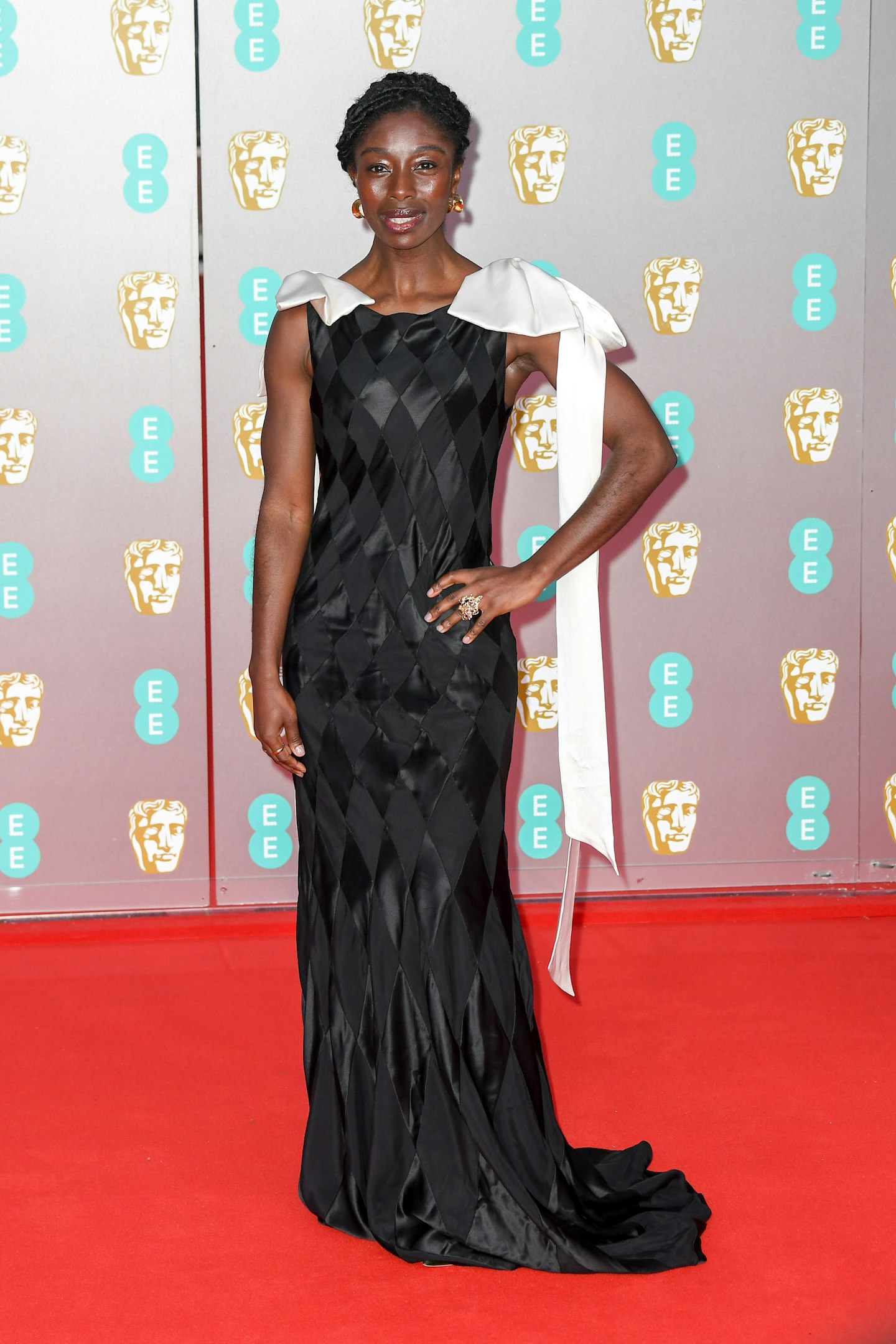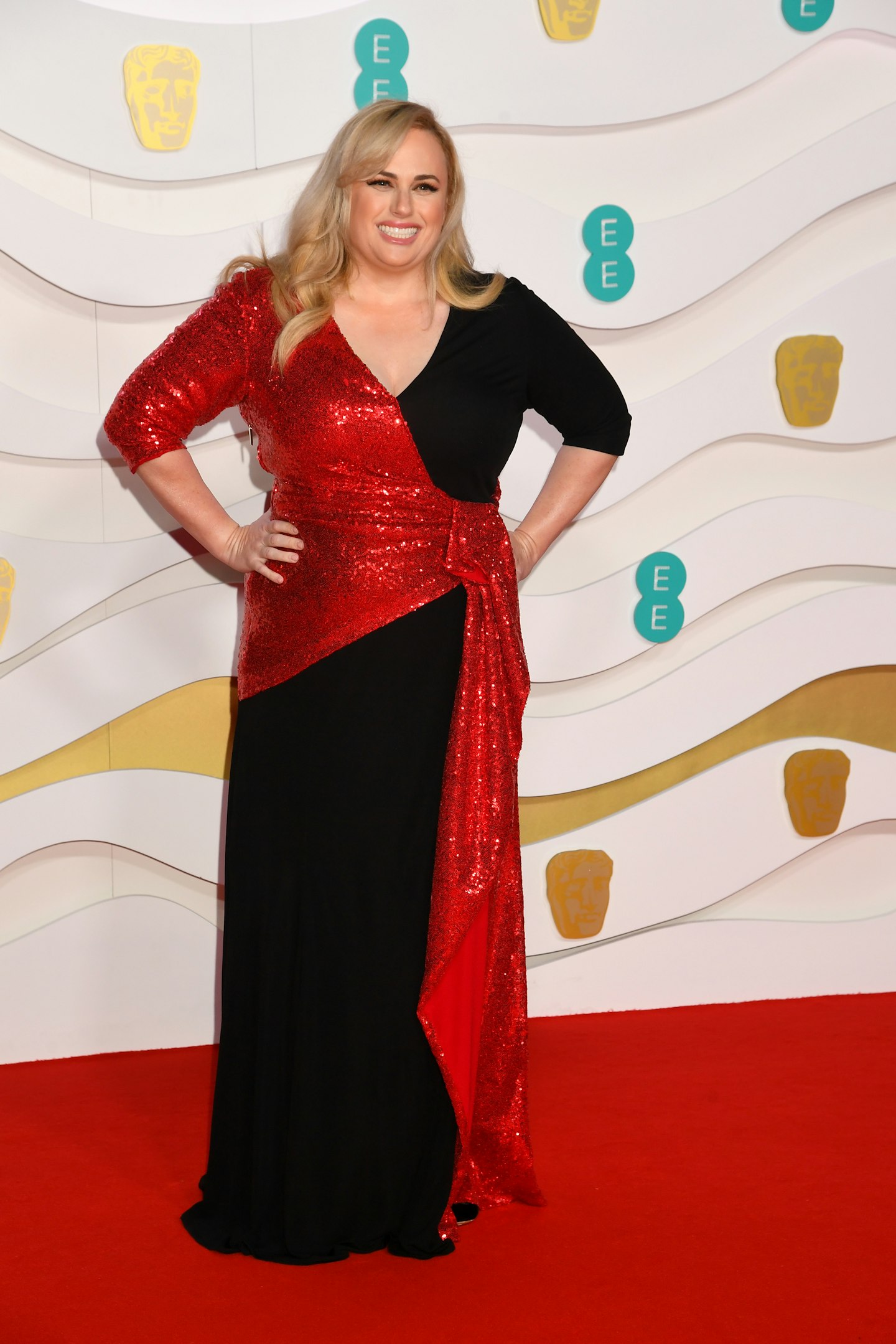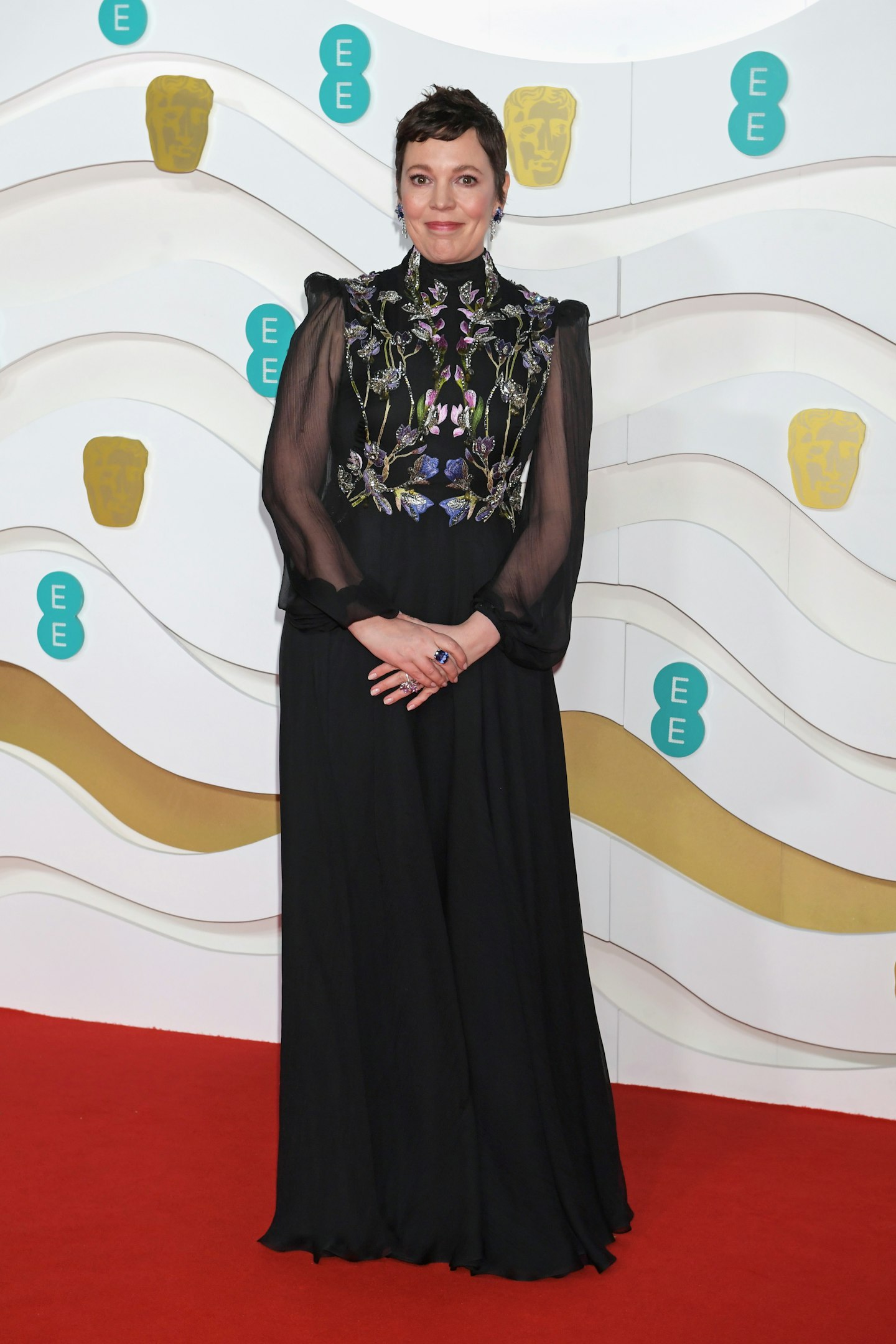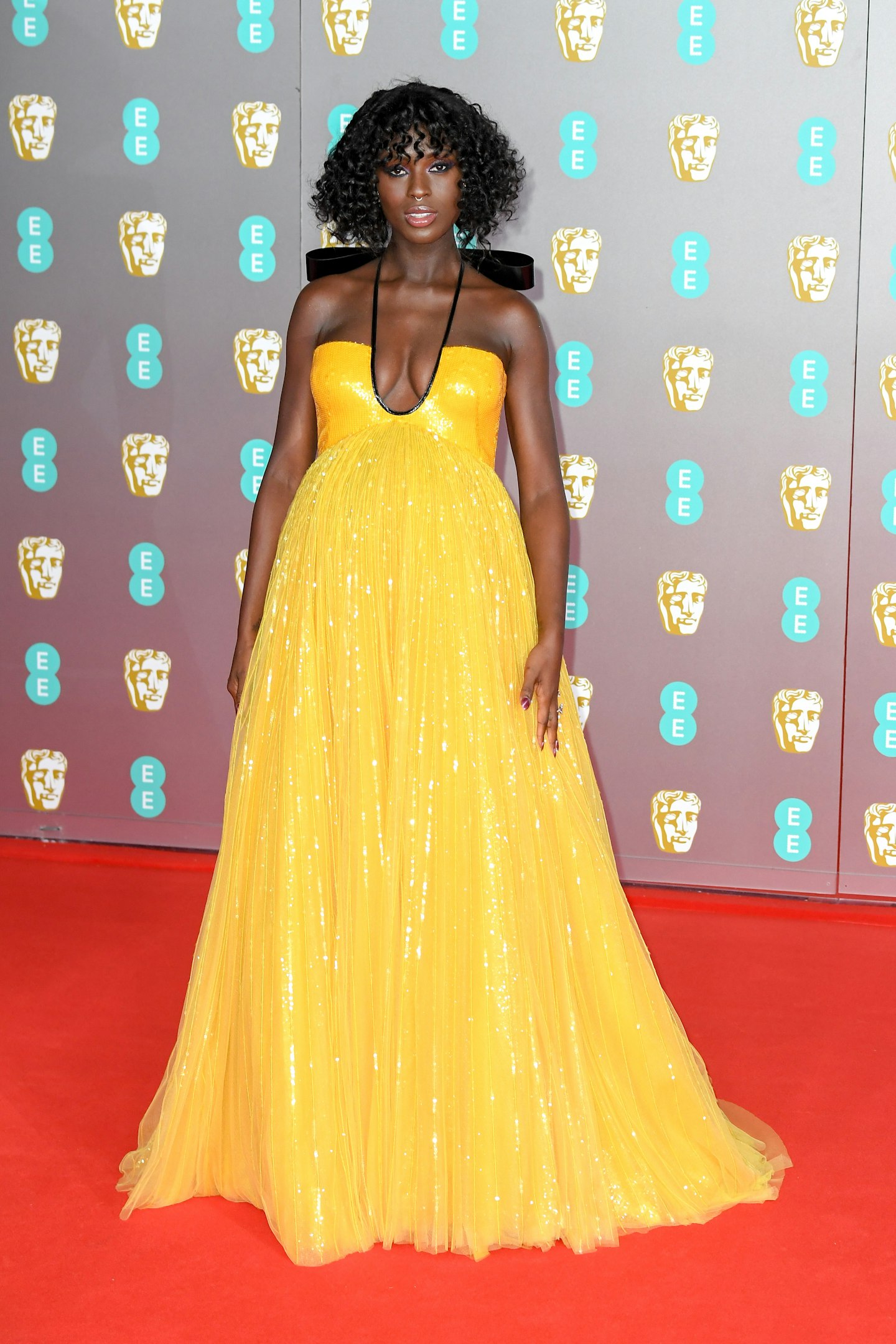Q: what did straight white men and environmental kudos have in common at the BAFTAs last night? A: easy wins.
But while Brad Pitt phoned in his Brexit and Prince Harry quips via the exquisite mouth of Margot Robbie, too many A-listers let the chance to make a statement pass them by.
It was billed as the carbon-neutral BAFTAs; an overdue attempt for Hollywood to make peace with our ever-increasing eco-anxiety, during a month of traditional glitz and excess for the world’s glossiest 1%-ers. And it all sounded so promising! Guests were served a (nearly) vegan meal, gift bags were swapped for a bundle of vouchers in a recycled plastic wallet, all those cross-Atlantic flights were carbon offset and even the red carpet was made from 100% recycled materials. But by far the most newsworthy shake-up was the Academy asking all guests to dress sustainably – either by re-wearing an outfit they already owned, or choosing another conscious fashion option such as upcycled materials, vintage or rental.
I was excited. During a month of interviews promoting my new book, How To Break Up With Fast Fashion, it’s an example I’ve reached for again and again: how powerful it would be to see stars on the red carpet proudly trotting out the same dress they wore last year, or even a few weeks earlier. How just a handful of influential frock-wearers could start a ripple effect to help relieve the collective consumerist pressure on us all. A butterfly beats its wings on an LA red carpet, and a few months later we all find ourselves standing in front of our wardrobe thinking ‘D’you know what? I’m just going to wear that dress again with different shoes.’
And here, finally, was the promise that it might actually happen. Would we see iconic red carpet moments, thrillingly recreated? Would we see celebrity hand-me-downs, hear stories of A-list swapping parties? Would anyone use DIY styling tricks, like wearing a ballgown back-to-front with a thermal poloneck underneath? Would anyone tell an eager reporter that their scent was Febreze? Would small, sustainable designers get an invaluable boost as some benevolent glamazon chose to wear their deadstock fabric creation, instead of another corseted whatever from Dior? Would this be the green carpet event that accelerated sustainable fashion into the mainstream public consciousness? Would it?

Well, no. As the stars sashayed to their seats and the outfit galleries emerged online, it became clear that most of the night’s big names had either ignored the sustainable dress code entirely, or complied with it in some very subtle but ultimately pointless way that nobody would actually know about. Like, maybe they had previously worn their dress for a whole two hours, in the privacy of their mansion? Or their diamonds were vintage, having conveniently belonged to Audrey Hepburn? I dunno. Either way, the looks were sensational but the roll call of designers was tediously familiar.
As far as I can tell the only stars who really aced to the assignment were Saoirse Ronan, god love her, whose inky Gucci gown was sewn from discarded satin, while looking about as far from the March sisters’ rag bag as a dress ever could, and the Duchess of Cambridge, who gamely re-wore a white and gold embroidered Alexander McQueen dress last spotted at a Malaysian state dinner in 2012. Say what you like about Kate, she knows how to meet a brief.
Then of course there was Joaquin Phoenix, making good on his promise to wear the same Stella McCartney tux to every event this awards season. But let’s not waste too much energy pretending that’s a noble feat. Phoenix is, after all, a man, and therefore blessed with the superpower of being able to wear the same clothes again and again until they disintegrate into vapour, without anybody actually noticing.
It’s unfair, of course it is, that this is a pressure and therefore a criticism fired almost exclusively at famous women. But the fact stands that it’s the famous women who have the greatest power to help the rest of us out of this mess – a mess where the world’s very poorest women (approximately 80% of global garment workers are women aged 18-35) are exploited along with the planet, to keep the rest of us buying more than we could ever wear or need, because we’ve internalised the message, somewhere along the way, that we’re only as good as our last outfit.
Anyway. I don’t doubt there were hundreds of other attendees who took the sustainability brief seriously and looked fabulous with it. I’d like to believe the after-parties were awash with vintage and thrift store finds, swishing with TENCEL™️ and organic cotton, filled with industry types preening in their Reformation and Mother of Pearl. But it’s hard for us mortals at home on the sofa to know that. While thousands of people attend awards ceremonies, only a tiny handful make the headlines.

And of course, if pressed, most of that tiny handful could probably have played the ‘something borrowed’ card. But please let’s not pretend that giving a custom-made dress back to a designer atelier for them to keep pristine in their archives is ‘sustainable’ in the same way that us swapping dresses with our mates to stop us buying another 372 wedding outfits is sustainable. Come now. Nobody was expecting the glitterati to make their own dress from old jeans and loo roll tubes, or rock up in a piece of bobbly St Michael from the charity shop, but would it have killed them to try a little harder? To work within those lucrative sponsorship deals and designer ‘friendships’ to find a way to look flawless, fierce and fashion-forward while flying the flag for a greener industry?
Because here’s the thing: sustainable fashion, just like the BAFTAs, has an inclusivity problem. Although things are rapidly improving, ethical and eco-friendly dressing is still harder if you’re not rich, thin, able-bodied and blessed with the luxury of time and resources. For the vast majority of people, ‘re-wearing’ isn’t even a legitimate phrase; it’s just called ‘wearing’, and it’s what clothes were invented for. But you know who is rich, thin, able-bodied and blessed with the luxury of time and resources (or at least, staff)? Oh wait, I know! The average Hollywood star.
Celebrities may not live like us, shop like us or dress like us, but they have the power to start trends, amplify conversations and reach well beyond the bubble of the liberal elite. Last night could have been a real turning point; a chance for the world to see that ethical fashion has evolved way beyond the old stereotypes of hemp and hand-wringing. A chance to prove that ‘sustainable’ and ‘drop dead gorgeous’ aren’t mutually exclusive.
But even beyond the moral obligation, from a purely cynical perspective, it would have been such a simple, no-brainer way for the celebs to pick up some brownie points. I almost want to shake them for missing such a golden opportunity. After all, people love a high profile re-wear! Remember how much we all cheered when Tiffany Haddish did it? We applaud when they take their heels off on the podium, we love it when they pack snacks in their clutch bags. I’m telling you, the first A-lister to wear the same dress for one whole awards season will have public goodwill coming out of their ears.
Maybe next year, it’ll happen. Maybe the establishment will finally cotton on, and old will become the new black. But for now, it seems the pressure to look perfect on the red carpet still trumps the desire to do better. I’m not angry, I’m just disappointed.
Lauren's book, How To Break Up With Fast Fashion is out now.
READ MORE: As BAFTA Sets A Sustainable Dress Code, We Ask If Red Carpet Dresses Can Ever Be Sustainable
See: All The Best Looks From The BAFTAs 2020
SEE: The best dressed at the BAFTAs 2020
 1 of 30
1 of 30Zoe Kravitz wearing Saint Laurent
 2 of 30
2 of 30Rhoda Ofori-Attah wearing Ong Oaj-Pairam, Rupert Sanderson shoes and Deborah Blyth jewellery
 3 of 30
3 of 30Vick Hope wearing Tran Hung
 4 of 30
4 of 30Emilia Clarke wearing Schiaparelli
 5 of 30
5 of 30Naomi Ackie wearing Valentino
 6 of 30
6 of 30Cinderella Balthazar
 7 of 30
7 of 30Jessie Buckley wearing Miu Miu and Atelier Swarovski jewellery
 8 of 30
8 of 30Gillian Anderson wearing Camilla & Marc
 9 of 30
9 of 30Naomie Harris wearing Michael Kors Collection
 10 of 30
10 of 30Ella Balinska wearing Giambattista Valli
 11 of 30
11 of 30Pixie Lott
 12 of 30
12 of 30Lily-Rose Depp wearing Chanel
 13 of 30
13 of 30Greta Gerwig
 14 of 30
14 of 30The Duchess of Cambridge wearing an Alexander McQueen gown that she last wore in September 2012 as part of the Diamond Jubilee tour in Malaysia
 15 of 30
15 of 30Vanessa Kirby in Valentino
 16 of 30
16 of 30Charlize Theron wearing Dior
 17 of 30
17 of 30Kaitlyn Dever wearing Miu Miu
 18 of 30
18 of 30Rebel Wilson wearing Prabal Gurung
 19 of 30
19 of 30Daisy Ridley wearing Oscar de la Renta
 20 of 30
20 of 30Saoirse Ronan wearing a Gucci gown made using discarded satin
 21 of 30
21 of 30Florence Pugh wearing Dries Van Noten
 22 of 30
22 of 30Renee Zellweger wearing Prada
 23 of 30
23 of 30Olivia Coleman wearing Alexander McQueen
 24 of 30
24 of 30Margot Robbie wearing Chanel and Rupert Sanderson shoes.
 25 of 30
25 of 30Zazie Beetz wearing Maria Moscone
 26 of 30
26 of 30Alice Eve wearing a Ralph & Russo dress from the Fall Couture 2017 collection
 27 of 30
27 of 30Rooney Mara wearing Givenchy
 28 of 30
28 of 30Scarlett Johansson wearing Atelier Versace
 29 of 30
29 of 30Jodie Turner-Smith wearing Gucci
 30 of 30
30 of 30